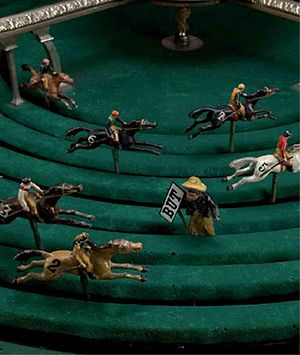Boules (gambling)

Boule (French for ball) is the name of a game of chance similar to roulette that emerged from Petits chevaux , popular in the 19th century .
The game of boules
The cauldron is divided into eighteen fields, these are numbered from one to nine, each number is represented twice. The numbers 1, 3, 6 and 8 are black, the numbers 2, 4, 7 and 9 are red, and the 5 is yellow.
Instead of an ivory ball as in roulette, a rubber ball is thrown in the boule game .
The betting options
Simple opportunities
- Rouge (Red: 2, 4, 7, 9) - Noir (Black: 1, 3, 6, 8)
- Pair ( Even : 2, 4, 6, 8) - Impair (Odd: 1, 3, 7, 9, without the 5)
- Manque (Low: 1, 2, 3, 4) - Passe (High: 6, 7, 8, 9)
The number five corresponds to the zero in roulette: If the boules falls on the five, all bets on the simple chances lose.
Multiple opportunities
- Plein : A set on a full number is paid out in the event of a win at a ratio of 7: 1.
- Cheval : A set on two numbers is paid out in the event of a win at a ratio of 3: 1.
Bank advantage
The bank advantage is 1/9 = 11.1% for all types of bets in the boules game. Boule is therefore very disadvantageous for the player. In roulette, for example, the bank advantage is 1.35% on the single chances and 2.70% on the multiple chances.
Boule is played at low stakes compared to roulette, especially in health resorts where there is no concession for the grand jeu , i. H. for a casino there.
Petits chevaux
With petits chevaux, also Jeu des petits chevaux or horse play, there are the same betting options as with boules . The winning number is not determined by throwing a ball, but by a mechanical device that simulates a horse race in miniature.
Petits chevaux was the forerunner of boules : the fans of some boules bowls are decorated with images of horses in memory of the petits chevaux . By 1900 Petits chevaux was a very popular casino game. A game table made by JA Jost (Paris around 1905) is on display in the Swiss Game Museum in La Tour-de-Peilz. In Baden-Baden casino was not until 2003 at the time of Iffezheimer race weeks a similar game, the horse Roulette Klondyke , played the game machine is now in the City Museum Baden-Baden .
In France, the name Petits chevaux is also used for a variant of Pachisi or Mensch, don't get angry ; the pieces are designed as jumpers , see Jeu des petits chevaux .
See also
literature
- Ralph Tegtmeier : Casino. The world of casinos, casinos of the world . DuMont, Cologne 1989, ISBN 3-7701-2225-9 (illustrated book)
- The Complete Hoyle's Games . Revised & updated by Lawrence H. Dawson, London 1950, Wordsworth Reference, reprint 1994, ISBN 1-85326-316-8
- Thierry Depaulis: The "Little Horses". A casino game of the Belle Epoque , in: U. Schädler (Hrsg.): Spiele der Menschheit. 5000 years of the cultural history of board games , WBG, Darmstadt 2007, ISBN 978-3-534-21020-6 , pp. 173-179

